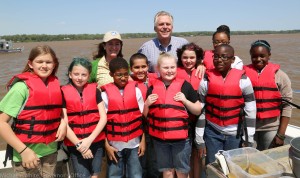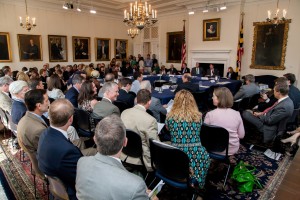By. Cyndy Merse, GSNN Content Writer
Advancing sustainability and environmental literacy at the state level can be a challenge. Expand this work across several states and the stakes become higher. With so many stakeholders and interests in play, can meaningful, impactful work be accomplished? Since the early 1980s, the partners of the Chesapeake Bay Program have been proving the impossible is possible and in a big way. One of their more recent accomplishments was the signing of the Chesapeake Bay Watershed Agreement on June 16, 2014. This agreement marks the first time that environmental literacy, and by extension sustainable schools, has been included as a goal to advance the restoration and protection of the Chesapeake Bay watershed.
What is the Chesapeake Bay Program?
Established in 1983, the Chesapeake Bay Program is a regional partnership consisting of federal and state agencies, local governments, non-profit organizations, and academic institutions that lead and direct the restoration and protection of the Chesapeake Bay. The Bay Program works on a wide array of issues, one of which is education for students and adults around the watershed itself and the importance of its restoration. For students, the Bay Program has an ambitious goal of ensuring every student in the Chesapeake Bay region has the opportunity to participate in meaningful watershed educational experiences from Kindergarten to 12th grade. To attain this goal, the Bay Program has an Education Workgroup that is a forum for cross-jurisdiction coordination and support for environmental education in the watershed, emphasizing:
- Increasing Meaningful Watershed Educational Experiences (MWEE) and other place-based, outdoor education activities.
- Supporting training for teachers and other environmental education professionals in content, pedagogy, and outdoor-learning techniques related to environmental topics.
- Encouraging green infrastructure and operations on school grounds.
- Supporting federal, state, and regional environmental literacy planning.
The Education Workgroup is also instrumental in evaluating and recommending policies related to preK-12 Bay education and tracking state implementation of MWEE in elementary, middle, and high schools.

Photo Courtesy of Michaele White, VA Governor’s Office
Reaching an Agreement
Since its founding, the Bay Program partners have used written agreements to guide the restoration efforts of the Bay and its watershed. Setting goals and tracking progress holds partners accountable, and developing new agreements over time ensures the Bay Program’s goals are aligned with the best available science. Student stewardship has been included in past Bay Program agreements, starting in 2000 and again in 2005.
Work on the 2014 watershed agreement began in 2009 when it became clear to Bay Program partners that a new agreement was needed to accelerate the pace of restoration and align federal directives with state and local goals. Citizens, stakeholders, academic institutions, and local governments, among others, were consulted during the drafting of the agreement to ensure it was more inclusive and that it addressed current and emerging environmental concerns. The new agreement also presented an opportunity for the Bay Program to build on its previous commitments to student stewardship and expand to more fully address environmental literacy for students in the watershed.
Developing the new agreement took many months. The Education Workgroup’s co-chairs, Shannon Sprague of the National Oceanic and Atmospheric Administration (NOAA) and Jamie Baxter from the Chesapeake Bay Trust, led the group’s efforts to identify goals and outcomes around environmental literacy. The group worked with a leadership team comprised of staff from the state education and natural resource agencies who challenged the workgroup to come up with goals and outcomes that were bold, yet measurable and attainable.
This was not an easy task. The Bay Program is a multi-state partnership and each state in the Chesapeake Bay watershed has its own set of unique challenges and opportunities in K-12 education. Driven by a collective belief in the value of environmental education and sustainable schools, the workgroup was committed to identifying goals that were reflective of the broad partnership and could be met by all jurisdictions. Their efforts resulted in the creation of an overarching environmental literacy goal for the Bay Program partnership, as well as several related outcomes. Feedback on the goal and outcomes was sought from the broader education workgroup membership (which includes approximately 50 education professionals from state and federal agencies, non-profits, and local schools) and the general public.
A Boost for Environmental Literacy
On June 16, 2014, representatives from the entire Chesapeake Bay watershed, including state governors and the mayor of Washington D.C., signed the Chesapeake Bay Watershed Agreement. The agreement contains ten interrelated goals, each linked to a set of outcomes, which advance the restoration and protection of the Bay watershed. Included for the first time is an environmental literacy goal: to enable students in the region to graduate with the knowledge and skills to act responsibly to protect and restore their local watershed.
The watershed agreement’s environmental literacy goal is linked to three related outcomes:
- Student Outcome: Continually increase students’ age-appropriate understanding of the watershed through participation in teacher-supported, meaningful watershed educational experiences and rigorous, inquiry-based instruction, with a target of at least one meaningful watershed educational experience in elementary, middle and high school depending on available resources.
- Sustainable Schools Outcome: Continually increase the number of schools in the region that reduce the impact of their buildings and grounds on their local watershed, environment and human health through best practices, including student-led protection and restoration projects.
- Environmental Literacy Planning Outcome: Each participating Bay jurisdiction should develop a comprehensive and systemic approach to environmental literacy for all students in the region that includes policies, practices, and voluntary metrics that support the environmental literacy goals and outcomes of the agreement.

Photo Courtesy of the Chesapeake Bay Program
Schools Benefit from Agreement
The 2014 watershed agreement offers an exciting opportunity to expand school sustainability, as well as environmental literacy, in the Chesapeake Bay watershed. Before, many school districts in the region were in different places regarding how they approached sustainability. With the sustainable schools outcome, state and federal agencies are required to develop plans with specific actions for supporting sustainable schools, including at the local level. These actions include:
- Promote and strengthen “sustainable school” certification and recognition programs consistent with high-quality, objective, and agreed-upon criteria (e.g., U.S. Department of Education Green Ribbon Schools program).
- Broaden stakeholder engagement to include a focus on health and nutrition, indoor air quality, chemicals, pest management, and other issues that might adversely affect school environmental health.
- Promote, develop, and/or disseminate needs assessments, training, technical resources, and promotional materials for relevant stakeholders.
- Identify and promote the use of best management practices at school sites.
Although much work remains to be done, the 2014 watershed agreement has sparked much enthusiasm and support for environmental literacy and school sustainability among the Bay Program partners and within the region itself. Through their work together, the Bay Program partners just might be setting a precedent for regional environmental literacy programs elsewhere in the United States.
References
Interview with Eric Rhoades, Director, Office of Science and Health Education, Virginia Department of Education; Kevin Schabow, Grant Programs Coordinator, NOAA Chesapeake Bay Office
Chesapeake Bay Program website (www.chesapeakebay.net)
